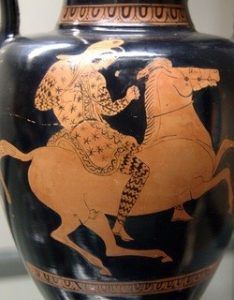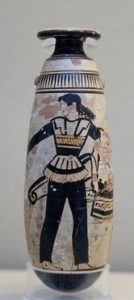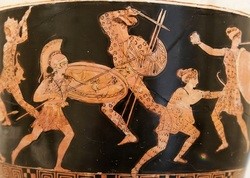May 26, 2015 by Steve Murray
Sounds of the Scythians – Greek Inscriptions Reveal Ancient Names

Scholars can glean information about the ancient Greeks by examining the images and writings on their pottery. Some vases contain nonsense inscriptions, however: combinations of Greek letters that don’t translate to any known words. One scholar played a hunch about these gibberish words and, in the process, gave voice to languages that hadn’t been heard for thousands of years.
Nonsense words
The work began with a study of 12 Greek vases in Athens from the period 550 B.C. to 450 B.C. Stanford University Research Scholar Adrienne Mayor and J. Paul Getty Museum Assistant Curator David Saunders translated inscriptions next to scenes of Amazons fighting, hunting, and shooting arrows. The inscriptions were written in ancient Greek but didn’t form Greek words, so they could only be transcribed by sounding out each letter.

Amazon in Scythian Dress (Wikipedia)
Mayor recognized that the people depicted on the vases wore clothing that matched those found in Scythian burials. Scythians were an ancient nomadic people who migrated from Central Asia to settle around what is now Crimea. Scythians both fought and traded with the Greeks.
Amazons were considered the stuff of myth until archaeologists unearthed Scythian burials of real women warriors. Athenians were fascinated with Amazons and began depicting them in their art before 550 B.C.. After a Scythian incursion into Thrace, the region north of Greece, Amazons were increasingly depicted wearing Scythian tunics, trousers, and hats, sitting on horses and carrying bows and axes.
Mayor wondered whether the apparent “nonsense” inscriptions associated with the Amazon and Scythian vase images might have real meanings.
The test
Mayor and Saunders tested their idea by submitting their phonetic Greek transcriptions to McMaster University (Canada) linguist John Colarusso, an expert on rare Caucasus languages like Circassian and Abkhazian. They provided Colarusso with no other information about the vases. With only the letter sounds to work with, Colarusso translated the inscriptions into names such as “Princess,” “Don’t Fail,” and “Hot Flanks.” He also identified an archer named “Battle-Cry” and a horsewoman named “Worthy of Armor. ”

Amazon “Worthy of Armor” (Wikipedia)
Because other, known figures such as Hercules and Achilles are found on vases together with their names, the researchers believe that the Amazon labels were also meant as names and not descriptions. The labels were probably nicknames or heroic designations given to Amazons, rather than real family names. Even today, Colarusso said, speakers of modern-day languages in the Caucasus region often use public, descriptive nicknames rather than reveal their real names.
Other translations appeared to confirm that these were phonetic transcriptions of ancient non-Greek tongues. One scene of a Scythian archer and dog contains an expression that translated to “the dog is sitting by him.” Another image of two Amazons hunting with a dog appears with a Greek transliteration for the Abkhazian word meaning “set the dog loose.”
Mayor tested the phonetic translation process by providing Colarusso with samples of true Greek-inflected gibberish. He wasn’t able to translate these artificial “plants.”
“I had goosebumps when I realized we were really deciphering sounds perhaps 3,000 years old,” Colarusso said.
Transliteration in the ancient world
The work was reported in the journal Hesperia, where the researchers suggest that ancient Greeks were trying to reproduce the sounds of Scythian names and words by writing them out phonetically with Greek letter combinations. In doing so, the Greeks may have preserved their early linguistic roots, and given scientists fresh insights into languages not spoken for millennia.
“It certainly has made me a lot more careful about what I call nonsense,” said Saunders.
Primary source:
Amazon Warriors’ Names Revealed Amid “Gibberish” on Ancient Greek Vases
